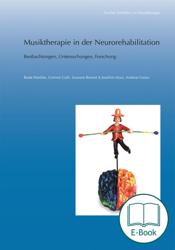In this book, research papers are published that describe the music therapy work with neurologically ill patients in the field of communication initiation, early rehabilitation and disease processing after brain injuries.
As pilot studies, they take up aspects that remain current in the course of the disease and make a contribution by focusing on music therapy approaches not yet investigated in various fields of practice in neurorehabilitation and by breaking new ground in research to expand the methodological spectrum. Case vignettes from everyday clinical practice enrich and clarify the approaches
Volume 6 of the Zürcher Schriften consists of four revised investigations from the practical field of neurorehabilitation, which were carried out at the Zurich University of the Arts.
The topics of the first and second part of the book by Corinne Galli and Beate Roelcke refer to neurologically severely affected people after a stroke. Galli presents a quantitative study of contact and compares elements of a verbal therapy procedure with non-verbal ones of music therapy. Roelcke uses a setting for working with patients with neglectsyndrome to show music therapy procedures that are in the area of conflict between functional and psychodynamic aspects.
The instruments developed by Joachim Marz, the treatment monochord and the kotamo, form the brackets of the third and fourth parts of the book. Andreas Vuissa examines the effect of a standardized relaxation method using Kotamo on people suffering from multiple sclerosis. Susanne Bossert & Joachim Marz are conducting a randomized and controlled study with the treatment monochord in people after accidental craniocerebral injuries.
The enumeration of the diagnosis groups described in the book shows the wide spectrum of diseases from which patients of neurorehabilitation suffer. Suddenly occurring brain injuries are next to slowly occurring chronic changes due to inflammatory processes in certain brain regions with their specific symptomatology. Both have drastic consequences for the way we live and place high demands on the patients' processing capacity.
The approaches of music therapy are correspondingly broad: music therapy methods and interventions are used from music-supported work with functional goals to psychodynamic support in disease processing, from the practicing level to the experience- and conflict-centered modality. The musical basis and the therapeutic relationship based on it form the common ground for all differences in the structure and outcome of the investigations.
With the aim of caring for patients in the best possible way, optimizing forms of treatment and contributing to the proof of effectiveness of music therapy on a quantitative and qualitative level, the investigations were adapted and carried out according to the clientele and clinical conditions. The present book is an invitation to think and research further in this rapidly developing field of work. Music therapy has the potential to take on a unique and irreplaceable task.
Beate Roelcke, born in 1963, after completing her studies in music therapy, initially worked in psychiatry. For 25 years she has been working in a Swiss clinic for neurorehabilitation, where she heads the team for creative therapies. Further training in Systemic Therapy and Neurological Music Therapy was complemented by an update course of studies leading to a Master of Advanced Studies in Clinical Music Therapy. For 11 years she has been co-director of the MAS in Clinical Music Therapy at the Zurich University of the Arts. Further professional activities include lectures and presentations in Switzerland and abroad as well as various further education programs in the field of music therapy.
Susanne Bossert, born in 1960, after obtaining the federal teaching diploma for music and movement at the Zurich Conservatory (today ZHdK) and a degree in art therapy, specializing in intermedial methods M.A., also completed her studies in music therapy. She has been working for 20 years as a music and art therapist in a Swiss accident clinic with neurological and orthopaedic patients and chronic pain patients. She also runs her own practice for music and art therapy and works as a musician. Continuing education, in addition to an upgrade course to the Master of Advanced Studies in Clinical Music Therapy, has led her to participate in various music and art therapy training courses as a lecturer, teaching therapist, supervisor and mentor.


 Sample
Sample